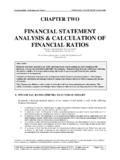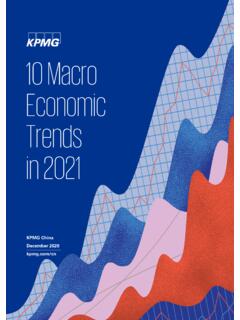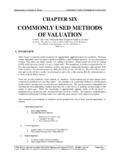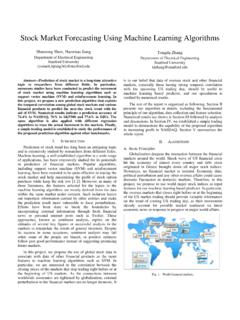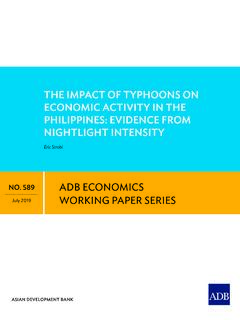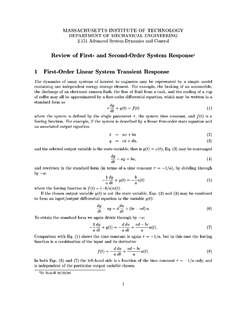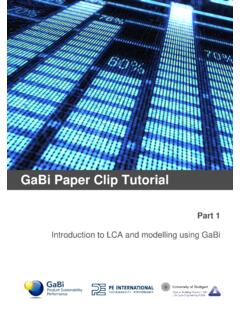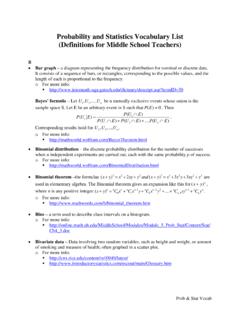Transcription of Metrics and tools for measuring construction productivity ...
1 NIST Special Publication 1101 Office of Applied EconomicsBuilding and Fire Research Laboratory Gaithersburg, Maryland 20899 Department of CommerceNational Institute of Standards and Technology Metrics and tools for measuring construction productivity : Technical and Empirical Considerations Allison L. Huang, Robert E. Chapman, and David T. Butry NIST Special Publication 1101 Department of CommerceNational Institute of Standards and Technology Office of Applied EconomicsBuilding and Fire Research Laboratory Gaithersburg, Maryland 20899 Metrics and tools for measuring construction productivity : Technical and Empirical Considerations Allison L.
2 Huang, Robert E. Chapman, and David T. Butry Sponsored by: National Institute of Standards and Technology Building and Fire Research Laboratory September 2009 DEPARTMENT OF COMMERCE Dr. Gary Locke, Secretary NATIONAL INSTITUTE OF STANDARDS AND TECHNOLOGY Dr. Patrick D. Gallagher, Deputy Director Abstract Although the construction industry is a major component of the economy, it has experienced a perceived prolonged period of decline in productivity . Due to the critical lack of measurement methods, however, the magnitude of the productivity problem in the construction industry is largely unknown.
3 The measurement problem is exacerbated by the fact that the construction industry is composed of four sectors that differ significantly in the outputs produced, firm size, and use of technology. The four sectors, which taken together define the construction industry, are residential, commercial/institutional, industrial, and infrastructure. This report describes efforts underway that focus on the measurement of construction productivity at three levels task, project, and industry and how such measurements can be developed.
4 This report analyzes the measurement challenges associated with the development of meaningful measures of construction productivity at the task, project, and industry levels and establishes a framework for addressing those challenges. Specifically, this report identifies the Metrics , tools , and data needed to move forward in collaboration with key construction industry stakeholders. Once produced, these Metrics , tools and data will help construction industry stakeholders make more cost-effective investments in productivity enhancing technologies and improved life-cycle construction processes; they will also provide stakeholders with new measurement and evaluation capabilities.
5 Finally, this report lays the foundation for future research and for establishing key industry collaborations that will enable more meaningful measures of construction productivity to be produced at the task, project, and industry levels. Keywords Building economics; construction ; economic analysis; information technology; labor productivity ; Metrics ; performance measurement; productivity iii iv Preface This study was conducted by the Office of Applied Economics in the Building and Fire Research Laboratory at the National Institute of Standards and Technology.
6 This report analyzes the measurement challenges associated with the development of meaningful measures of construction productivity at the task, project, and industry levels and establishes a framework for addressing those challenges. The intended audience is the National Institute of Standards and Technology, as well as, other government agencies that compile and publish construction -related statistics, private sector organizations concerned about the perceived decline in construction productivity , and standards development organizations that produce standards used by the construction industry.
7 Disclaimer Certain trade names and company products are mentioned in the text in order to adequately specify the technical procedures and equipment used. In no case does such identification imply recommendation or endorsement by the National Institute of Standards and Technology, nor does it imply that the products are necessarily the best available for the purpose. Disclaimer Regarding Non- Metrics Units The policy of the National Institute of Standards and Technology is to use metric units in all of its published materials.
8 Because this report is intended for the construction industry that uses customary units, it is more practical and less confusing to use customary units rather than metric units. Measurement values in this report are therefore stated in customary units first, followed by the corresponding values in metric units within parentheses. Cover Photograph Credits DigitalVision construction in Action clip gallery image used in compliance with DigitalVision s royalty free digital stock photography use policy.
9 V vi Acknowledgements The authors wish to thank all those who contributed so many excellent ideas and suggestions for this report. They include Mr. Mark E. Palmer, Leader of the Computer-Integrated Building Processes Group in the Building and Fire Research Laboratory (BFRL) at the National Institute of Standards and Technology (NIST), for his technical guidance, suggestions, and support. Special appreciation is extended to Mr. Douglas Thomas of BFRL s Office of Applied Economics (OAE) for his thorough review and many insights and to Ms.
10 Carmen Pardo for her assistance in preparing the manuscript for review and publication. Special appreciation is also extended to Professor Paul M. Teicholz, Professor Emeritus in Civil and Environmental Engineering at Stanford University, for the many stimulating exchanges that have truly improved this report. The report has also benefited from the review and technical comments provided by Dr. Nicos S. Martys and Ms. Geraldine Cheok of BFRL s Materials and construction Research Division. vii viii Table of Contents Abstract.










